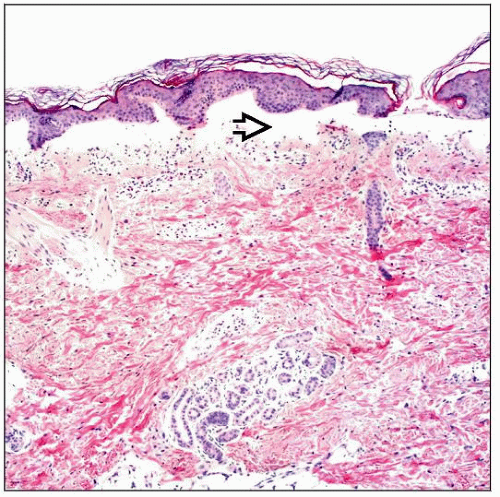Epidermolysis Bullosa, Inherited
Jessica M. Comstock, MD
Key Facts
Terminology
Heterogeneous group of noninflammatory inherited disorders characterized by development of blisters or erosions after minor trauma
Etiology/Pathogenesis
Autosomal dominant or recessive
Clinical Issues
50 per 1,000,000 live births
92% EB simplex
Symptomatic treatment
EB simplex: Generally mild, blisters heal without scarring
Mostly autosomal dominant
Recessive forms tend to be more severe
Junctional EB: Very rare, autosomal recessive
Dystrophic EB: Trauma-induced blisters that heal with scarring
Microscopic Pathology
All forms in routine histology generally show cell-poor subepidermal blister
Immunofluorescence (or immunohistochemistry) may help subclassification
Biopsy from edge of fresh blister
Ancillary Tests
Antibody mapping of basement membrane zone most useful, performed at specialized laboratories
Top Differential Diagnoses
Porphyria cutanea tarda
Bullous pemphigoid
Toxic epidermal necrolysis
 This clinical photo of dystrophic epidermolysis bullosa shows blisters, erosions, and loss of toenails. |
TERMINOLOGY
Abbreviations
Epidermolysis bullosa (EB)
Definitions
Heterogeneous group of noninflammatory inherited disorders characterized by development of blisters or erosions after minor trauma
ETIOLOGY/PATHOGENESIS
Inherited
Autosomal dominant or recessive
Basement membrane zone is composed of numerous specialized components that are defective in EB
Basal cell cytoskeleton
Anchoring filaments
Collagen fibrils
EB simplex
Mutations in keratin 5, keratin 14
Junctional EB
Mutations in laminin 5, integrin, type XVII collagen
Dystrophic EB
Mutations in type VII collagen gene
Acquired
Autoimmune
CLINICAL ISSUES
Epidemiology
Incidence
50 per 1 million live births
92% EB simplex
5% junctional EB
1% dystrophic EB
2% unclassified
Gender
No predilection
Ethnicity
No predilection
Endoscopic Findings
Important to assess GI tract for blisters
Treatment
Symptomatic
Wound healing
Infection
Nutrition
Oral care
Squamous cell carcinoma
Gene or protein therapies are being studied
Bone marrow transplantation may be curative
Prenatal and preimplantation testing is available
EB Simplex
Generally mild, blisters heal without scarring
Mild to no internal involvement
Mostly autosomal dominant
Recessive forms tend to be more severe
Generalized type
Blisters at birth or early infancy
Mostly on hands and feet but may be anywhere
Localized type
Onset usually within first 2 years of life
Blisters confined to hands and feet
EB herpetiformis
Onset in 1st few months of life
Blisters may be hemorrhagic
Herpetic arrangement on face, trunk, extremities
Can have mucosal, nail involvement
EB simplex with muscular dystrophy
Defect in plectin
May also have tooth decay, urethral stricture, respiratory complications, alopecia
Muscular dystrophy may be late onset
Degree of blistering does not correlate with degree of muscular dystrophy





